Table of Contents
Ever felt like choosing hiking boots is like navigating a minefield of options? You’re not alone. We’ve all been there.
We stare at rows of boots. We wonder if we’ll spend a lot of money on something that’ll hurt our feet when we hike. It’s enough to make you want to stick to the sofa, right?
But here’s the thing: your feet deserve better, and so do you. Whether you’re a weekend warrior or a seasoned trekker, the right boots can make or break your adventure. No more blisters, no more soggy socks, no more regrets.
Ready to find your perfect pair? Let’s lace up and dive into our top eight picks for 2024 that’ll keep you comfy and sure-footed. From gentle nature walks to gruelling mountain ascents. Trust me, your feet will thank you.
Alright, let’s lace up and hit the trail with our comprehensive guide to the best hiking boots of 2024!
Our Trail-Tested Method: How We Chose the Best Boots
We didn’t just pick these boots out of thin air, you know. Our team of avid hikers put each pair through its paces, covering hundreds of miles across diverse terrains. From muddy forest paths to rocky mountain trails, we’ve tested these boots in conditions that’d make your average footwear quiver in fear.
We’ve tested hiking boots in conditions that’d make your average trainer cry for mercy. From muddy bogs to rocky scrambles, we’ve put these boots through their paces.
And let me tell you, some of our testers’ feet have stories to tell! But that’s how we make sure our recommendations aren’t just hot air – these tested hiking boots have earned their stripes (and probably a good wash).
We evaluated each boot based on comfort, durability, traction, waterproofing, and weight. Because let’s face it, nobody wants to feel like they’re dragging bricks up a mountain, do they? Our expert panel includes seasoned backpackers, day hikers, and even a podiatrist – because happy feet make for happy hikers!
Boot Basics: Your Guide to Happy Feet on Any Trail
Types of Hiking Boots
Lightweight/Day Hiking Boots: These are the sprinters of the hiking world. Perfect for short trips or well-maintained trails, they’re like trail runners on steroids. They offer more protection than your average trainers but won’t weigh you down.
Midweight Boots: The all-rounders. These boots strike a balance between support and weight, making them ideal for weekend warriors tackling varied terrains. Think of them as the Swiss Army knives of hiking footwear.
Heavyweight/Backpacking Boots: Now, let’s talk about the classic choice: leather boots. These sturdy companions have been the go-to for serious hikers for decades, and for good reason.
Leather boots are like the tanks of the hiking world – they’re tough, protective, and if you treat them right, they’ll last for years. They might take a bit more breaking in than their synthetic cousins, but once you’ve moulded them to your feet, you’ll have a loyal friend for many trails to come.
Just remember, like a fine wine, leather boots get better with age – but unlike wine, they improve with use, not by sitting in a dark cupboard!
Key Features to Consider
Waterproofing: Nothing ruins a hike faster than soggy socks. Look for boots with waterproof membranes like Gore-Tex, or water-resistant materials like waterproof nubuck leather. But remember, what keeps water out also keeps it in – so consider breathability too!
Breathability: Speaking of which, a good pair of hiking boots should let your feet breathe. Mesh uppers are great for ventilation, but they’re not as durable as leather. It’s all about finding that sweet spot between airflow and protection.
Ankle Support: High ankles aren’t just a fashion statement. They provide crucial support on uneven terrain. But if you’re sticking to well-maintained trails, you might prefer the freedom of movement that comes with lower ankles.
Traction: A sticky rubber outsole is your best friend on slippery surfaces. Many top brands use Vibram outsoles, known for their excellent grip. But remember, even the best rubber won’t stick to pure ice!
Don’t forget to check out the lug pattern on the sole. It’s like the tread on your car tyres – deeper, more aggressive lugs will give you better grip in mud and loose terrain.
Weight: Every gramme counts when you’re miles from civilisation. Lighter-weight boots are less fatiguing, but they often sacrifice durability and support. It’s a balancing act, folks!
Importance of Proper Fit
Finding the right fit is like finding your soulmate – it might take some time, but it’s worth the effort. A good fit should give you plenty of room in the toe box (about a thumb’s width), while holding your heel firmly in place. And don’t forget to try boots on later in the day when your feet are slightly swollen – just like they would be on a hike!
Pay attention to the lacing system, too. A good lacing system isn’t just about keeping your boots on – it’s about customising the fit to your foot. Some boots even have fancy locking laces that let you adjust the tightness in different areas. It’s like having a personal boot fitter on the trail!
2024’s Top 8: The Best Hiking Boots That’ll Make You Fall in Love with Hiking
1. Best Overall: Salomon X Ultra 4 Mid GTX – £170
The Salomon X Ultra 4 Mid GTX is a true jack-of-all-trades in the hiking world. With its lightweight design (only 425g per boot) and sturdy construction, it’s like having your cake and eating it too. The Contagrip MA outsole provides excellent traction on varied terrain, while the Gore-Tex lining keeps your feet dry in wet conditions.
Pros:
- Lightweight yet supportive
- Excellent traction on various surfaces
- Waterproof and breathable
Cons:
- May not be enough for heavy backpacking loads
- Durability not as good as expected
Best for: Day hikes and light backpacking trips across diverse terrains.
Available in: Ellis Brigham, Cotswold, Amazon
2. Best Value: Keen Targhee – £140
The Keen Targhee has been a favourite among hikers for years, and for good reason. These boots offer a winning combination of durability, comfort, and affordability. The waterproof nubuck leather upper and KEEN.DRY waterproof membrane keep your feet dry, while the ESS shank provides lightweight support.
Pros:
- Excellent value for money
- Good water resistance
- Roomy toe box for comfort
Cons:
- Not as durable as some high-end models
Best for: Budget-conscious hikers looking for reliable performance on moderate trails.
Available at: Ellis Brigham, Amazon
3. Most Comfortable: Hoka Kaha 2 GTX – £190
Slip your feet into the Hoka Kaha 2 GTX, and you might forget you’re wearing hiking boots at all. These boots feature Hoka’s signature thick midsole, providing exceptional cushioning for long days on the trail. The Vibram Megagrip outsole provides solid traction, while the event’s waterproof bootie keeps your feet dry.
Pros:
- Exceptional comfort and cushioning
- Excellent traction
- Waterproof and breathable
Cons:
- May feel too cushioned for those who prefer a more ground feel
Best for: Hikers prioritising comfort on long-distance treks or those with sensitive feet.
Available in: Ellis Brigham, Alpine Trek, Mr Porter
4. Most Durable: Asolo Fugitive GTX – £247
When it comes to toughness, the Asolo Fugitive GTX is hard to beat. These boots are built to last with a suede and Cordura upper, and a solid Vibram sole. The Gore-Tex lining provides waterproofing, while the high ankle provides excellent support for rough terrain.
Pros:
- Extremely durable construction
- Excellent ankle support
- Reliable waterproofing
Cons:
- Heavier than some other options (693g per boot)
Best for: Rugged trails and long-term use in challenging conditions.
Available in: Amazon, Trade Inn, Castleberg Outdoors
5. Best for Backpacking: Salomon Quest 4 GTX – £210
For those multi-day adventures with a heavy pack, look no further than the Salomon Quest 4 GTX. These boots offer superb ankle support and stability, thanks to their high cut and ADV-C 4D chassis. The Contagrip TD outsole provides excellent traction, while the Gore-Tex membrane keeps water out.
Pros:
- Excellent support for heavy loads
- Superior traction on varied terrain
- Durable and waterproof
Cons:
- May be overkill for casual day hikes
Best for: Serious backpackers tackling challenging terrain with heavy loads.
Available in: Decathlon, Go Outdoors, Cotswold Outdoor
6. Best for Day Hikes: Danner Mountain 600 Leaf GTX – £220
The Danner Mountain 600 Leaf GTX combines classic style with modern performance. These boots feature a full-grain leather upper and a Vibram SPE midsole for comfort on day-long hikes. The Vibram Fuga outsole with Megagrip technology provides excellent traction on both wet and dry surfaces.
Pros:
- Stylish design suitable for both trail and town
- Comfortable out of the box
- Good traction on various surfaces
Cons:
- May not provide enough support for heavy backpacking
Best for: Day hikers who appreciate a blend of style and performance.
Available in: Lockwoods, Stuarts, Nomad
7. Best Lightweight Option: HOKA Speedgoat 5 Mid GTX
If speed is your game, the HOKA Speedgoat 5 Mid GTX is your boot. Weighing in at just 388g per boot, these are more like beefed-up trail runners than traditional hiking boots. The Vibram Megagrip rubber outsole provides excellent traction, while the Gore-Tex membrane keeps your feet dry.
These lightweight boots are perfect for those who want to feel fleet-footed on the trail. They’re like the sports cars of the hiking world – nimble and fast, but maybe not the best for rough terrain.
Pros:
- Extremely lightweight
- Excellent cushioning
- Good traction on varied terrain
Cons:
- Less ankle support than traditional hiking boots
Best for: Fast-and-light hikers and those transitioning from trail running shoes.
Available in: Ellis Brigham, Cotswold Outdoor, Alpine Trek
8. Best for Wide Feet: Keen Pyrenees – €160
Finding comfortable boots for wide feet can be a challenge, but the Keen Pyrenees rise to the occasion. These boots feature a spacious toe box and come in wide sizes. The waterproof membrane keeps your feet dry, while the outsole provides reliable traction.
Pros:
- Accommodates wide feet comfortably
- Affordable price point
- Lightweight for a hiking boot
Cons:
- May not provide enough support for very technical terrain
Best for: Hikers with wide feet looking for comfort on moderate trails.
Available in: Amazon, Nevisport, Castleberg Outdoors
Remember, the best boot for you is the one that fits your feet and meets your hiking needs. Happy trails!
Find Your Perfect Match: A Foolproof Boot Buying Guide
Assess Your Needs
Before you get caught up in the excitement of boot shopping, take a moment to think about what you actually need. Are you planning on conquering Everest, or just taking leisurely walks in the local park? The type of hiking you’ll be doing will greatly influence your choice.
Consider the terrain you’ll be tackling most often. Rocky mountain paths demand stiffer soles and better ankle support, while well-maintained forest trails allow for lighter, more flexible options. And don’t forget about the weather – if you’re hiking in Seattle, waterproofing might be more crucial than if you’re trekking through Arizona.
Consider Your Foot Type
We’re all unique, and that includes our feet. High arches, flat feet, wide feet, narrow heels – your foot shape plays a crucial role in finding the perfect boot.
If you’ve got high arches, look for boots with good cushioning to absorb shock. Flat-footed? You’ll want a boot with good stability to prevent overpronation.
And let’s not forget about width. If you’ve got wide feet, don’t try to squeeze into narrow boots – you’ll regret it halfway up the mountain. Many brands offer wide options, so don’t settle for less than a perfect fit.
Top Tip: Before you pick the size of the boots you want, decide which socks you want to wear. I wear two pairs of socks; one thin pair to wick sweat, and a thick pair to cushion my feet. I rarely get blisters.
This means I need slightly bigger hiking boots than my normal size in shoes and boots. Decide on your socks before you choose your boot size, and take them to the shop when trying boots on. – Will Hawkins
Try Before You Buy
Here’s a revolutionary idea – actually try on the boots before you buy them! I know, in this age of online shopping, it seems almost quaint. But trust me, your feet will thank you.
When you’re trying on boots, wear the socks you’ll be hiking in. Walk around, try going up and down stairs, even jump a bit if you’re feeling adventurous (and the shop assistants don’t mind).
Pay attention to how your heel sits – it should be snug but not tight. Your toes should have enough room to wiggle, but your foot shouldn’t slide around inside the boot. And remember, boots often feel different after a few hours of wear, so don’t rush the decision.
Extend Your Boot’s Life: Essential Care Tips for Every Hiker
Taking care of your boots isn’t just about making them last longer (although that’s a nice bonus). It’s about making sure they perform at their best when you need them most. Nobody wants their waterproofing to fail halfway through a rainy hike!
Start by cleaning your boots after each hike. A soft brush and some warm water will do for most dirt and mud. For tougher stains, use a specialised boot cleaner – avoid harsh detergents as they can damage the leather or waterproof membranes.
Once they’re clean, apply a waterproofing treatment if needed. How often depends on how often you hike, but a good rule of thumb is to re-waterproof when water stops beading on the surface of your boots.
When you’re not hitting the trails, store your boots in a cool, dry place. Stuff them with newspaper to help them keep their shape and absorb any lingering moisture. And whatever you do, don’t dry them by the fire – intense heat can damage the glue that holds your boots together.
Tread Lightly: Eco-Friendly Boots for the Conscious Adventurer
Today, we can’t ignore the environmental impact of our gear. Fortunately, many boot manufacturers are stepping up to the plate with eco-friendly options.
Look for boots made with recycled materials – everything from plastic bottles to coffee grounds is finding its way into our footwear. Some brands are even experimenting with biodegradable materials for certain components.
But sustainability isn’t just about materials – it’s about longevity too. A boot that lasts for years is far better for the environment than one you have to replace every season.
This is where repairability comes in. Some high-end boots can be resoled, extending their life significantly. It might cost more upfront, but your wallet (and the planet) will thank you in the long run.
Conquer Any Season: Choosing Boots for Year-Round Hiking
Just as you wouldn’t wear a parka in the desert, your choice of hiking boots should change with the seasons.
For summer hikes, breathability is key. Look for boots with mesh panels or breathable membranes to keep your feet cool and dry. Lighter colours can also help reflect heat.
Winter hiking, on the other hand, calls for insulation and superior waterproofing. Some boots come with built-in insulation, while others leave room for thick socks. And when it comes to traction, winter boots often feature more aggressive tread patterns to bite into snow and ice.
But what if you’re not keen on buying multiple pairs of boots? Look for all-season options with removable liners. These versatile boots can adapt to different conditions, making them a great choice for hikers who experience a range of weather conditions.
Remember, there’s no such thing as bad weather, only inappropriate footwear!
Beyond One-Size-Fits-All: Boots for Every Foot and Need
You’ve journeyed through our guide, and now it’s time to lace up and hit the trails! Your first step? Get yourself to an outdoor shop and try on those top picks. Remember, the perfect boot is out there, ready to support you through muddy paths and rocky ascents alike.
Don’t let fear of the wrong choice keep you from exploring the great outdoors. With the knowledge you’ve gained, you’re well-equipped to find your ideal hiking partner. So, what are you waiting for?
The mountains are calling, and your new boots are itching to answer. Go on, take that first step towards comfort, durability, and unforgettable adventures!
Hiker’s Corner: Your Burning Boot Questions Answered!
Is it OK to wear hiking boots for walking?
Absolutely! Your trusty hiking boots can be great for everyday strolls. They offer support and durability, but might be overkill for a quick jaunt to the shops. Use your judgement – if it’s comfy, go for it!
Are Salomon the best hiking boots?
Salomon makes cracking boots, but ‘best’ is subjective. They’re known for quality and innovation, but the best boot for you depends on your needs. Don’t just follow the crowd – find what fits your feet and adventures!
What kind of hiking boots does Bear Grylls wear?
Bear’s often spotted in Merrell boots, but he’s not married to one brand. Remember, what works for a survival expert might not suit your Sunday ramble. Focus on finding your own perfect match rather than copying celebrities.
Is it better to have loose or tight hiking boots?
Neither! You want a Goldilocks fit – not too loose, not too tight, but just right. Your heel should be snug, with wiggle room for your toes. A perfect fit means happy feet on the trail!
Should hiking boots be heavy or light?
It depends on your hike! Heavier boots offer more support for rough terrain and heavy loads, while lighter ones are great for day hikes. Consider your typical adventures when choosing – your feet will thank you!
Is there a difference between hiking and walking boots?
Yes, but it’s not black and white. Hiking boots are generally sturdier and offer more support for rough terrain. Walking boots are lighter for easier paths. But many boots blur the lines – choose based on your typical activities.
What hiking boots did Cheryl Strayed wear?
In ‘Wild’, Cheryl wore Raichle boots, which Mammut now makes. But don’t get hung up on celebrity choices – your perfect boot might be completely different. Focus on what works for your feet and your adventures!
What is the difference between combat boots and hiking boots?
Combat boots are built for durability in harsh conditions, while hiking boots prioritise comfort and trail performance. Hiking boots are usually lighter and more flexible. Stick to hiking boots for the trail – your feet will be happier!
Should your toes touch the end of your hiking boots?
No way! You want about a thumb’s width of space in front of your toes when standing. This prevents painful toe-bashing on descents. Remember, a bit of room is your friend on the trail!
Why are my hiking boots uncomfortable?
Could be several reasons – wrong size, insufficient break-in, or they’re just not right for your feet. Don’t suffer in silence! Try different lacing techniques, insoles, or consider that these might not be your sole mates after all.
Should you get a bigger size for hiking boots?
Not necessarily bigger, but you might need a different size than your everyday shoes. Your feet swell when hiking, so try boots on in the afternoon, and wear hiking socks. The right size means happy hiking!
Which boots are best for hiking?
There’s no one-size-fits-all answer! The best boots depend on your foot shape, hiking style, and terrain. Check out our top picks in the article above, but remember – the best boot is the one that fits you perfectly.
How do I look good in hiking boots?
Confidence is key! Pair them with the right socks and trousers, and wear them proudly. Remember, on the trail, performance trumps fashion.
The best look? A smile because your feet feel great!
Should hiking boots be over the ankle?
It depends on your needs. Over-ankle boots offer more support for rough terrain and heavy loads. But for easy trails, lower-cut boots can be more comfortable. Consider your typical hikes when choosing.
Are hiking boots supposed to have arch support?
Most do, but the level varies. If you need extra support, look for boots with good arch support or use custom insoles. Your arches should feel cradled, not strained. Happy arches mean happy hikes!
Is it OK to walk in hiking boots?
Absolutely! They’re designed for walking, after all. Just remember, they might be overkill for short, urban walks. For longer walks or uneven terrain, lace ’em up and enjoy the support!
What boots did Holly Willoughby wear in the jungle?
Holly sported Grenson boots in the jungle. But remember, celebrity choices aren’t always practical for real hiking. Focus on finding boots that suit your needs, not a TV star’s wardrobe!
What boots does Bear Grylls wear on Running Wild?
Bear often wears Merrell boots on his shows. But don’t just copy Bear – your feet and adventures are unique. Focus on finding boots that suit your needs and fit your feet perfectly.
What hiking boots do the military use?
Military boots vary by country and role, but they’re often heavier and more durable than typical hiking boots. For civilian hikes, stick to boots designed for trails – they’ll be more comfortable and suitable.
What are the disadvantages of combat boots?
For hiking, combat boots can be heavier, less breathable, and less flexible than dedicated hiking boots. They’re built for durability, not trail comfort. Stick to hiking boots for the best outdoor experience.
Should hiking boots be tighter or looser?
Neither! You want a perfect fit – snug in the heel to prevent blisters, but with enough toe room to wiggle. Too tight or too loose can lead to discomfort and injuries. Take time to find your perfect fit!
Why do my feet hurt after hiking in boots?
Could be ill-fitting boots, insufficient break-in, or your feet adjusting to new support. Don’t ignore pain – it could lead to injuries. Try different lacing techniques, insoles, or consider if these boots are right for you.
Can hiking boots be used for everyday use?
Sure, if you find them comfortable! They’re durable and supportive, which can be great for daily wear. Just remember they might be overkill for some situations, and could wear out faster with constant use.
Are hiking boots good for walking on concrete?
They can be, thanks to their support and durability. However, they’re not specifically designed for hard surfaces. For regular urban walking, you might prefer lighter, more flexible footwear.
Can you wear normal socks with hiking boots?
You can, but it’s not ideal. Hiking-specific socks provide better cushioning, moisture-wicking, and blister prevention. Treat your feet to proper hiking socks – they’re an investment in comfort!
Why are hiking boots better than runners?
Hiking boots offer more ankle support, durability, and protection on rough trails. They’re better for carrying heavy loads, too. But for easy trails or if you prioritise speed, trail runners might be your best bet.
What’s the point of hiking boots?
Hiking boots provide support, protection, and traction on varied terrain. They keep your feet dry, prevent blisters, and can carry heavier loads. Basically, they’re your best friends on the trail!
What’s the difference between hiking and walking boots?
Hiking boots are generally sturdier, with more ankle support for rough terrain. Walking boots are lighter, more flexible, and designed for easier paths. But many boots sit somewhere in between – choose based on your usual activities.
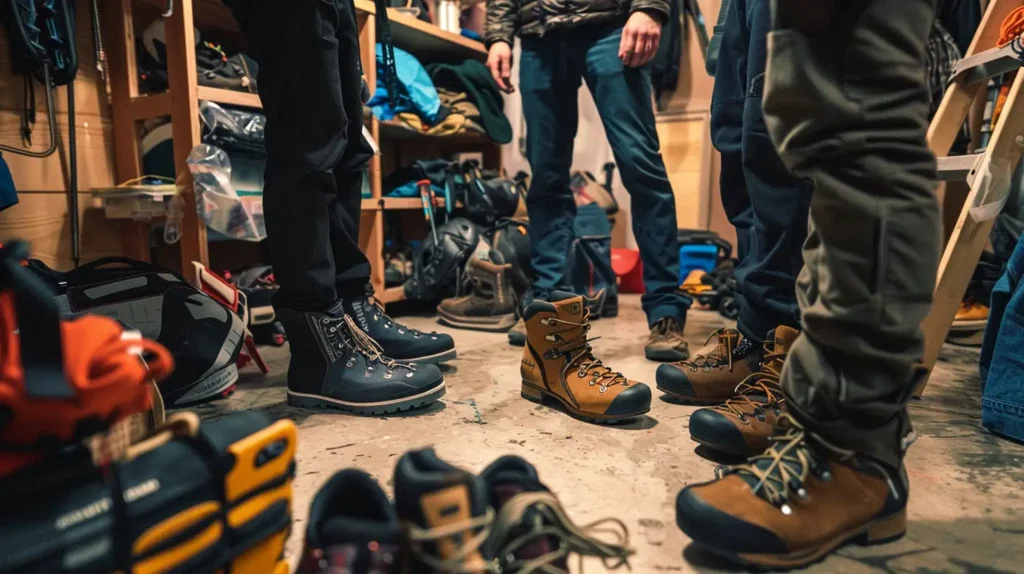
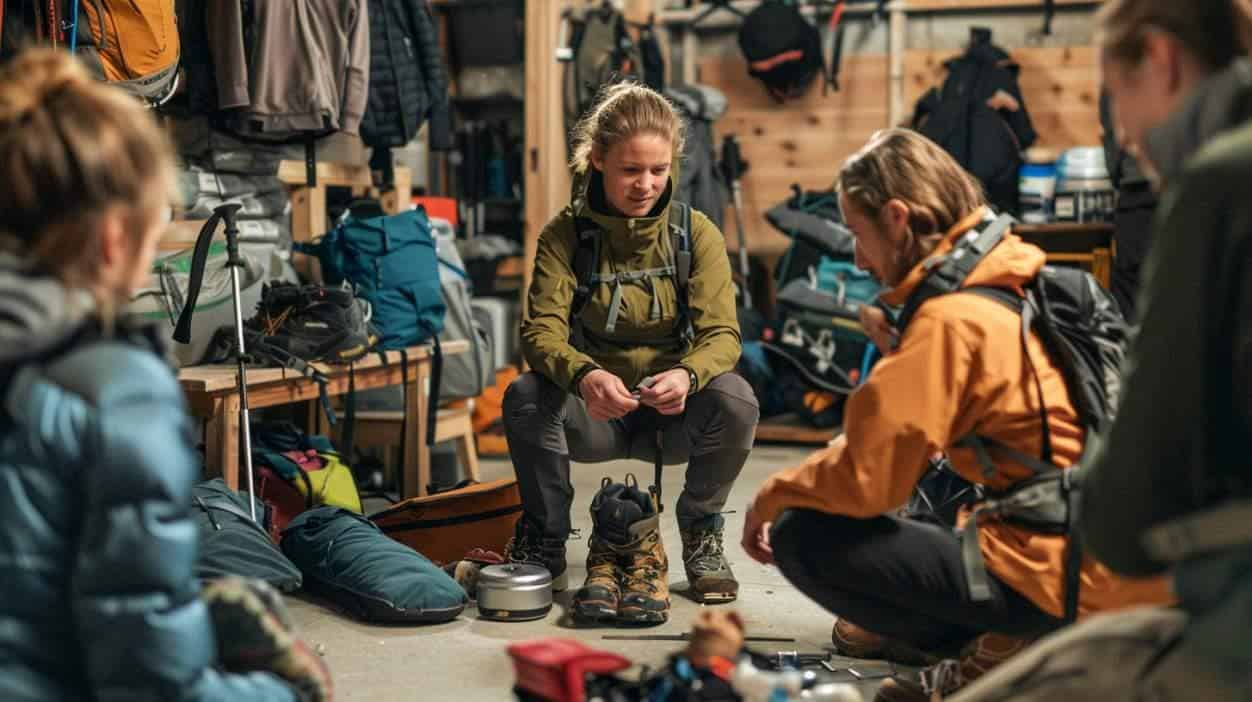
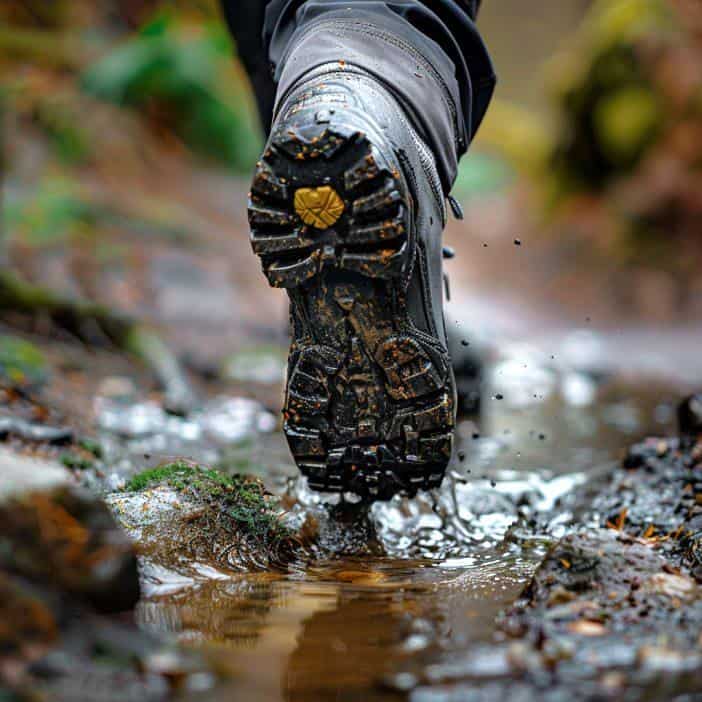
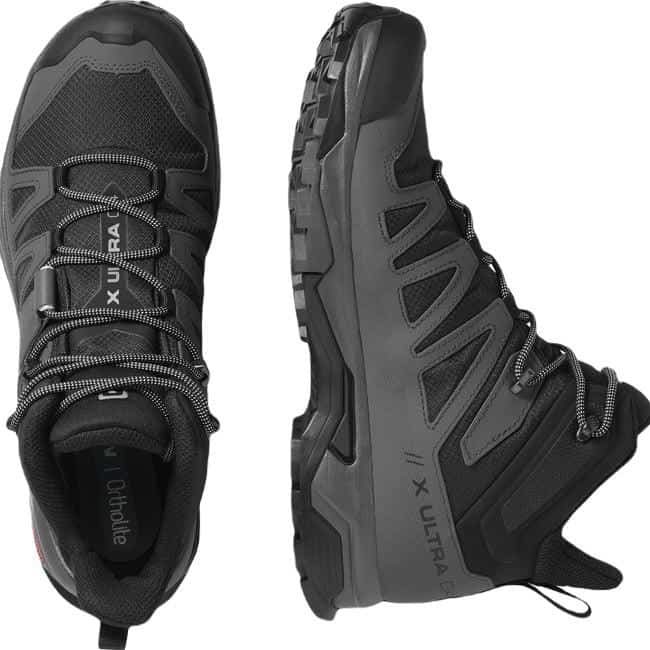
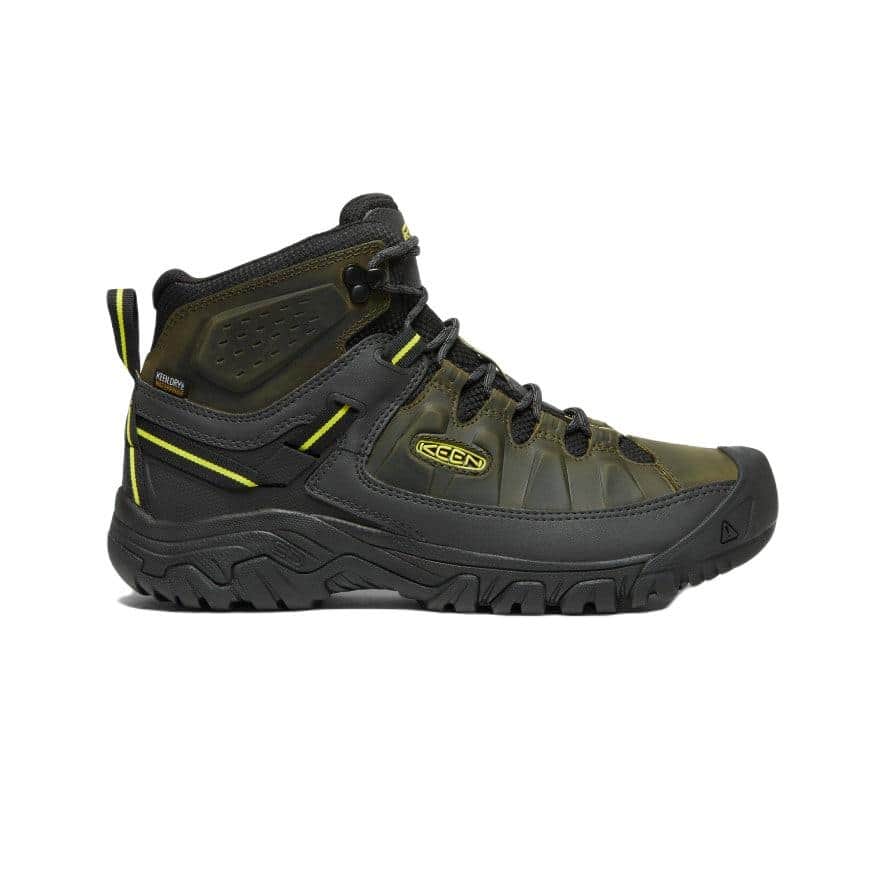
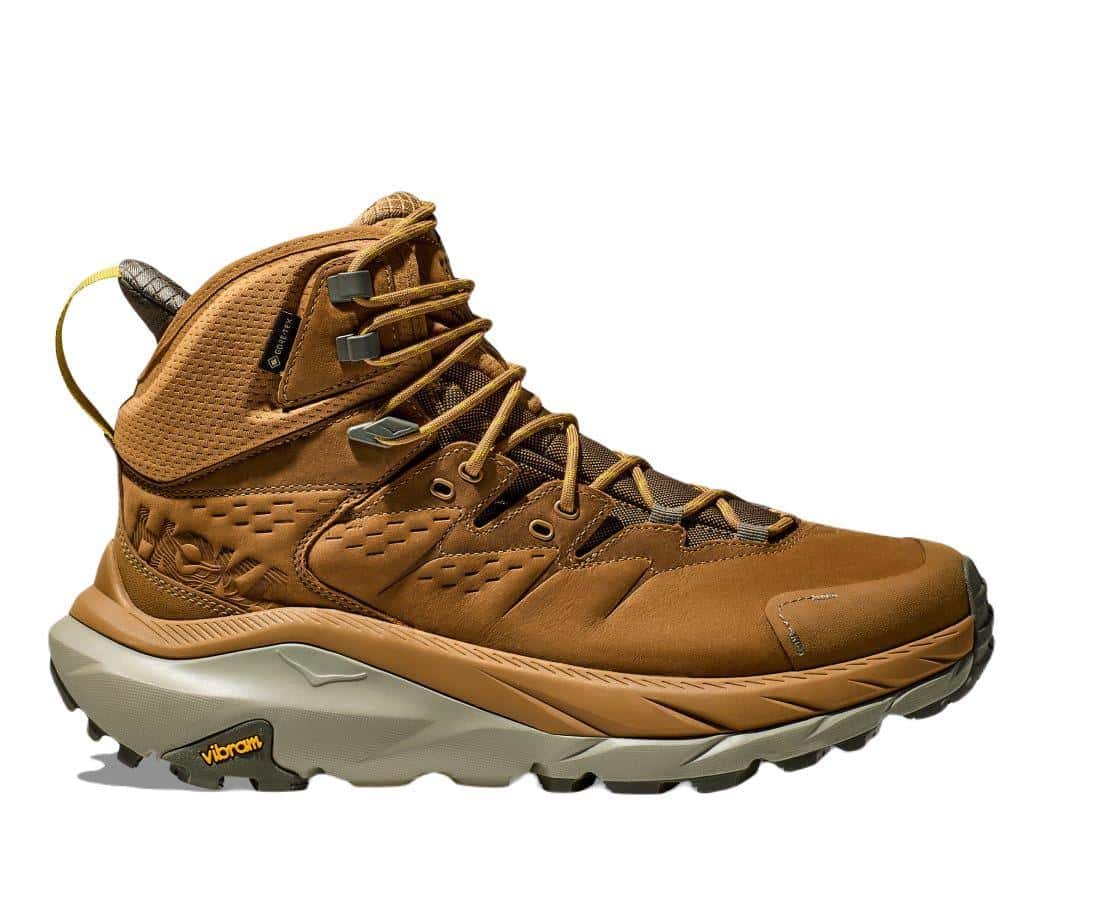
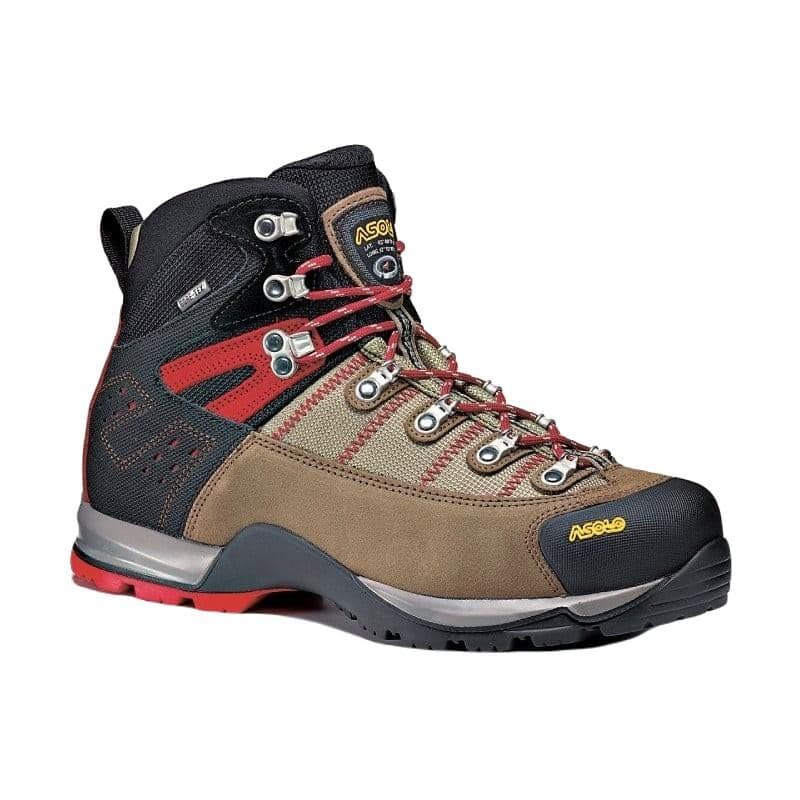
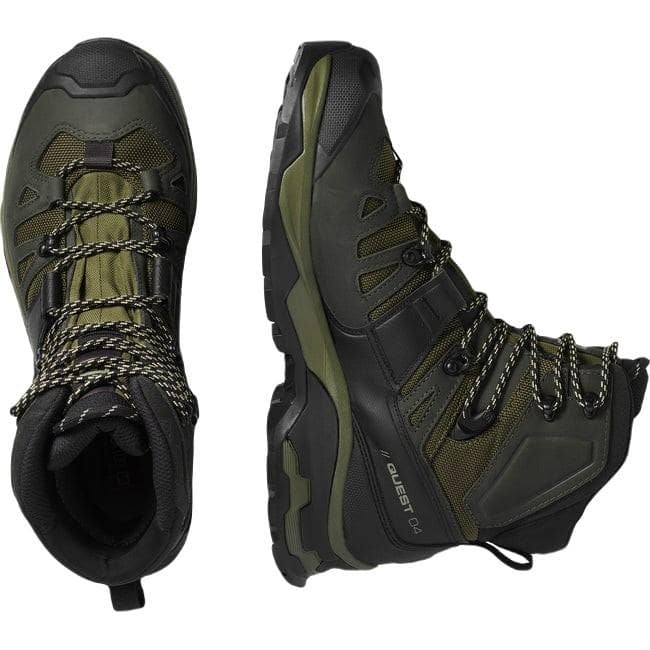
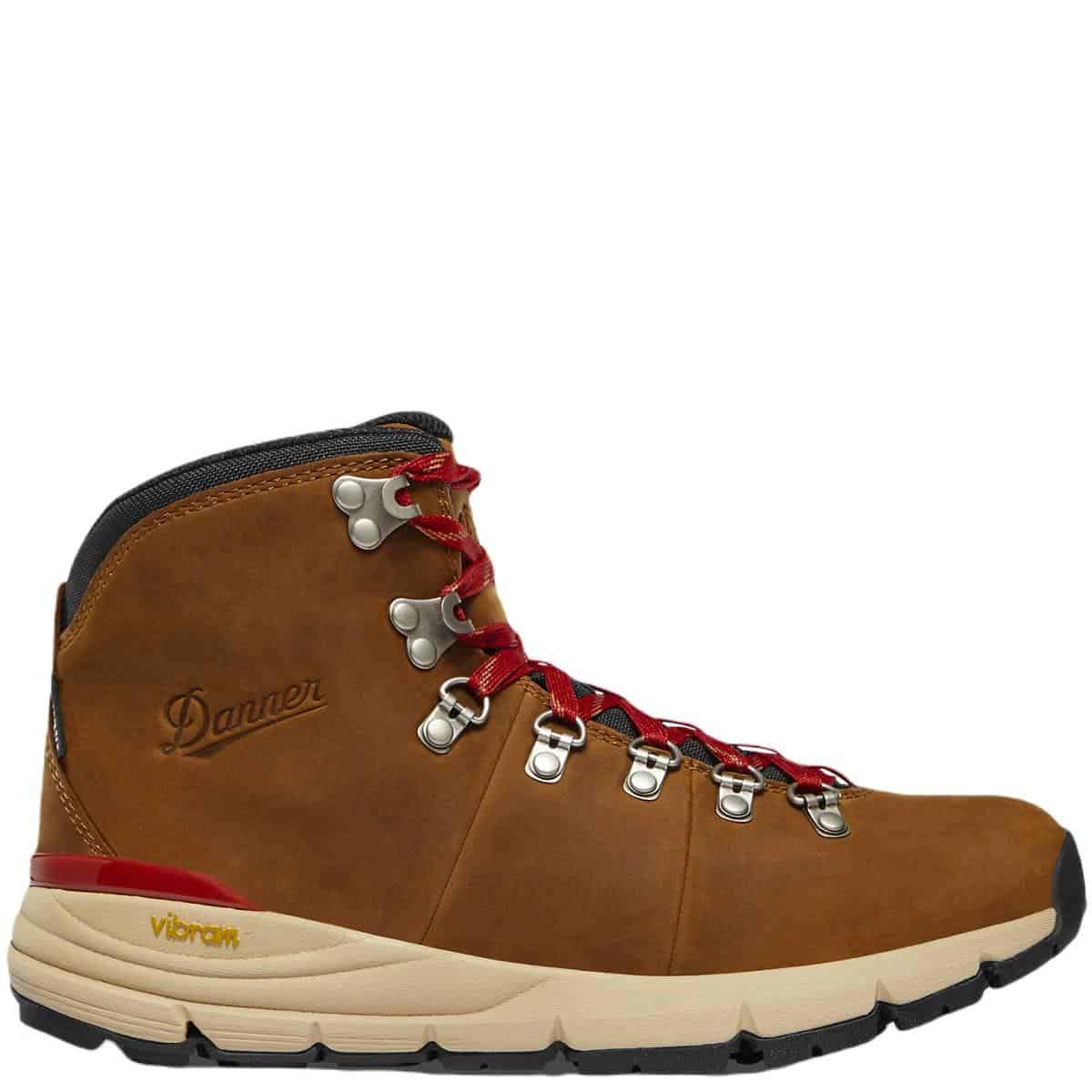
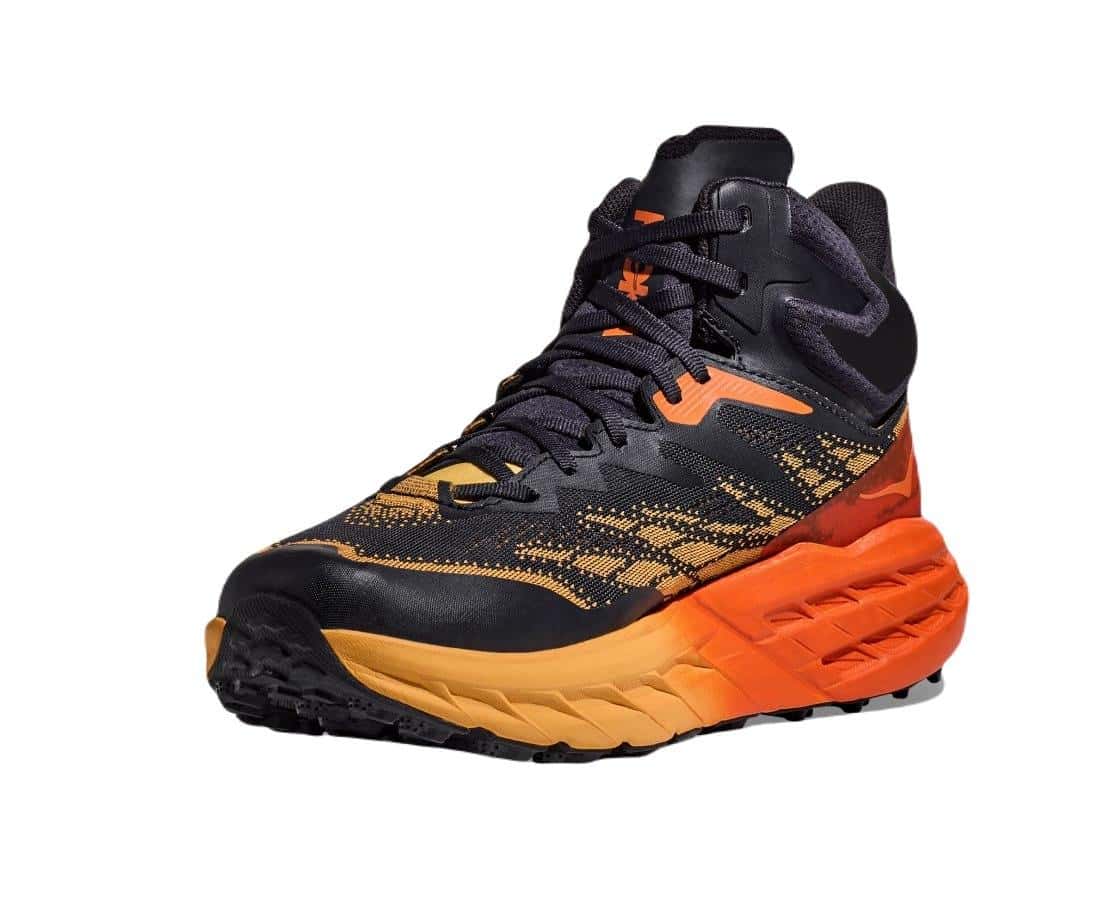




Pingback: Are Hiking Boots Safety Boots? - WB Hawkins
Pingback: Beat the Downpour: 15 Best Waterproof Hiking Trousers [2023]